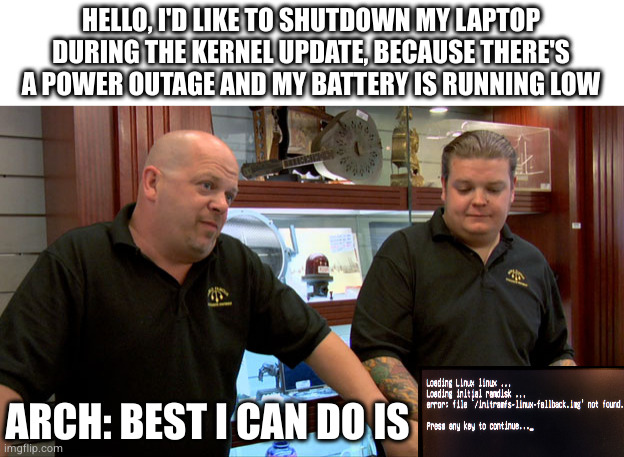this post was submitted on 04 Aug 2024
320 points (87.7% liked)
linuxmemes
21180 readers
809 users here now
Hint: :q!
Sister communities:
- LemmyMemes: Memes
- LemmyShitpost: Anything and everything goes.
- RISA: Star Trek memes and shitposts
Community rules (click to expand)
1. Follow the site-wide rules
- Instance-wide TOS: https://legal.lemmy.world/tos/
- Lemmy code of conduct: https://join-lemmy.org/docs/code_of_conduct.html
2. Be civil
- Understand the difference between a joke and an insult.
- Do not harrass or attack members of the community for any reason.
- Leave remarks of "peasantry" to the PCMR community. If you dislike an OS/service/application, attack the thing you dislike, not the individuals who use it. Some people may not have a choice.
- Bigotry will not be tolerated.
- These rules are somewhat loosened when the subject is a public figure. Still, do not attack their person or incite harrassment.
3. Post Linux-related content
- Including Unix and BSD.
- Non-Linux content is acceptable as long as it makes a reference to Linux. For example, the poorly made mockery of
sudoin Windows. - No porn. Even if you watch it on a Linux machine.
4. No recent reposts
- Everybody uses Arch btw, can't quit Vim, and wants to interject for a moment. You can stop now.
Please report posts and comments that break these rules!
founded 1 year ago
MODERATORS
you are viewing a single comment's thread
view the rest of the comments
view the rest of the comments

arch-chrootyour mounted root filesystem/bootmkinitcpio -p linuxSteps 1,2 and 3 are the entry way to solve all "unbootable Arch" problems by the way, presuming you know what needs to be changed to fix it of course.
I'd gladly take an Arch wiki article
https://wiki.archlinux.org/title/Chroot
+
https://wiki.archlinux.org/title/Mkinitcpio
For a while, I had to do this after every kernel update
Turns out, i accidentally had two
/bootfolders. One was is own partition, and the other was on the rootfs partition. When Arch booted, the separate partition was mounted over the rootfs/bootdir, "shadowing" itExcept, UEFI / GRUB was still pointing to the rootfs partition. So when pacman installed a kernel update, it wasn't able to update the kernel that UEFI was booting, but it was able to update the kernel modules
Kernel no likey when kernel modules are newer than the kernel itself